Struggling with Oily Scalp & Dandruff? Here’s What You’re Missing
Introduction: Understanding the Connection Between Oily Scalp and Dandruff
- Many people struggle with hair issues all the time. Whether you have oily roots the day after washing, an itchy scalp during meetings, or peeling on your shoulders at social gatherings, these are not little annoyances.
- Greasy scalp and flakes These are chronic problems that impact appearance, comfort, and confidence. Dandruff and an oily scalp are often misinterpreted as the two main causes of many of these issues. They frequently have a deeper connection than most people realise, which is surprising.
- Many people believe that dryness is the cause of dandruff, which leads them to use thick, hydrating shampoos or oil their hair more frequently.
- Ironically, this well-meaning attempt may make matters worse, particularly if the true issue is excessive oil production coupled with an overabundance of the naturally occurring scalp fungus Malassezia.
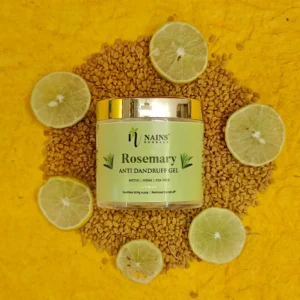
- Let’s simplify: sebum, or natural oils, are produced by your scalp to maintain the hydration of your skin and hair. However, an excess of this sebum—caused by hormone fluctuations, unclean hair, or even stress—makes the ideal conditions for the growth of fungi.
- Dandruff is the visible flaking that results from irritation of the scalp caused by this overgrowth.
- Treating oily dandruff the same manner one would dry scalp flakes is perhaps one of the most frequent errors people make.
- Assuming their scalp requires moisture, individuals frequently skip washings or apply thick oils, but in actuality, they can be smothering the pores and encouraging the growth of fungi.
- In addition to making the dandruff worse, this causes hair loss, clogged follicles, and increased oiliness.
- As a formulation specialist with knowledge of natural ingredient science and scalp biology, I can state with confidence that maintaining clean hair isn’t the only aspect of scalp health.
- It involves controlling sebum, maintaining a healthy scalp microbiota, and employing products that target the underlying problem rather than simply the symptoms.
- All too frequently, people try home cures that lack scientific support or purchase anti-dandruff shampoos that only offer short-term relief, which results in a cycle of recurrent flare-ups.
- Everything you need to know about dandruff and oily scalp will be covered in this blog, including why it occurs, which myths to dispel, and which scientifically proven treatments can provide long-lasting relief.
- This guide is intended to provide you the tools you need to properly manage the health of your scalp, from identifying the triggers to selecting the best formulations and regular routines.
- You’re not alone if you’ve ever pondered why your scalp feels oily the day after washing, why flakes persist despite your best efforts, or why itching is most intense during humid weather. More significantly, there are remedies available to you.
- Join us as we unravel the mystery of dandruff and greasy scalps and reveal what you’ve been missing.
1. Why an Oily Scalp Often Leads to Dandruff
- A common misconception is that dandruff is a dryness issue. However, it frequently results from an overly greasy scalp.
- Understanding the processes underlying oil production, the function of the scalp’s microbiota, and the distinctions between oily and dry dandruff types is crucial for effective dandruff management and prevention.
- To help you understand each component, let’s dissect it.
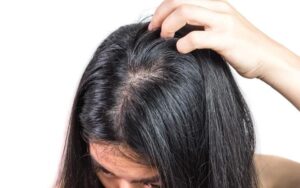
- Sebum Overproduction: A Covert Trigger
- The natural oil that the scalp’s sebaceous glands produce is called sebum. It is crucial for maintaining the hydration of the scalp and hair, guarding against dryness and environmental harm. On the other hand, excessive sebum production can block hair follicles, trap debris, and form a sticky surface that promotes accumulation.
- Excess sebum production can result from a number of factors:
- Unbalanced hormones (such as elevated testosterone)
- Washing the hair too much or too little
- Heat and high humidity
- Stress and unhealthy eating patterns
- Utilising harsh or inappropriate hair care products
- Most individuals are unaware that this overproduction upsets the normal balance of microorganisms on your scalp in addition to making your hair oily.
- How Excess Oil Feeds Malassezia Fungus:
- Numerous microorganisms, like as bacteria and fungi, can be found on the human scalp. Everybody’s skin naturally contains one of these fungi, Malassezia.
- Under normal circumstances, it lives in harmony with humans. But this fungus becomes unmanageable when sebum levels are high.
- Excessive oil provides the ideal breeding habitat for Malassezia, which grows best in lipid-rich conditions.
- Triglycerides are broken down into fatty acids as it consumes the oils, which can irritate the scalp and cause the classic dandruff symptoms of irritation, redness, and flaking.
- This explains why people with oily scalps frequently have itchy, greasy flakes that don’t go away, especially on the crown of the head, behind the ears, and around the hairline.
- There is more to comprehending the relationship between greasy scalp and dandruff than superficial fixes.
- It’s about honouring your scalp’s biology. You can proceed towards long-term alleviation rather than short-term solutions by addressing the underlying reasons, such as oil regulation and fungal balance.
- As we go deeper into how lifestyle, hair care routines, and ingredient selections affect the health of your scalp and how to ultimately end the cycle of oily dandruff, stay tuned.
2. Mistakes You Might Be Making in Your Hair Care Routine
- It can be annoying to deal with dandruff and an oily scalp, but our regular hair care routines are frequently the true cause.
- By using the incorrect products, believing falsehoods, or engaging in unhygienic practices, many people unintentionally harm the health of their scalps.
- It might be time to consider whether you’re making these simple yet crucial blunders if your flakes and greasiness persist despite your best efforts.
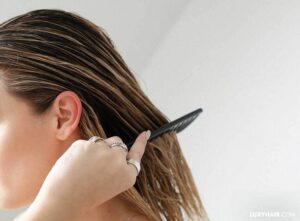
- Using Harsh Anti-Dandruff Shampoos Too Frequently:
- Typically, anti-dandruff shampoos contain active chemicals that effectively reduce fungal overgrowth, such as zinc pyrithione, ketoconazole, selenium sulphide, or coal tar.
- Overuse or everyday use of them, however, might deplete your scalp’s natural oils, leading to irritation and rebound oil production.
- Additionally, some contain powerful detergents or sulphates that over time exacerbate dryness and irritation.
- Many people think that shampooing more vigorously is the answer if dandruff continues, however this frequently backfires.
- The scalp barrier may be weakened by inflammation caused by strong washes, leaving the scalp more susceptible to Malassezia and more oil imbalance.
- What to do instead: To preserve the integrity of your scalp, use medicated shampoos as directed or two to three times per week, alternating them with a gentle, pH-balanced shampoo.
- Over-Washing or Under-Washing Your Hair:
- When natural oils are depleted by frequent hair washing, the scalp responds by creating additional oil.
- However, infrequent washing causes perspiration, sebum, and product residue to build up, which fosters the growth of fungi and clogged follicles.
- Your lifestyle and hair type will determine the best frequency of washing, but for most people with oily scalps, washing two to three times a week with the appropriate products keeps things clean without going overboard.
- Advice: After bathing, observe how your scalp feels for 24 to 48 hours. You may be using the incorrect shampoo or overwashing if it becomes oily too quickly.
- Ignoring Scalp Hygiene and Build-Up:
- We frequently give our hair strands all of our attention—conditioning, masking, and oiling—while utterly ignoring the scalp. This eventually results in the buildup of:
- Product residue (dry shampoo, sprays, and serums):
- Pollutants in the environment
- Dead cells in the skin
- Too much sebum
- This accumulation clogs follicles and pores, exacerbating dandruff and possibly causing hair loss. Resetting your scalp environment can be achieved by using clarifying shampoos, detox masks, or scalp exfoliation once every ten to fifteen days.
- Pro Tip: To get rid of residue without damaging the scalp barrier, use mild, non-abrasive scalp washes or clay-based detox treatments.
- Using Hair Oils That Clog Pores:
- There is a widespread misperception that dandruff may be resolved by oiling the scalp. However, using heavy or comedogenic oils (such as coconut oil in humid weather) to treat an oily scalp might smother hair follicles and encourage fungal infection.
- The majority of traditional oiling techniques retain heat and debris, which exacerbates scalp inflammation, even if certain oils, such as neem, tea tree, or rosemary, have antifungal qualities.
- Better Method: Choose mild, non-comedogenic oils, rinse well after using them, and use scalp-friendly oils sparingly (once a week). If your scalp is already oily or itching, don’t leave it overnight.
3. Natural Ingredients That Balance Oil and Fight Dandruff
- Some of the best treatments for dandruff and greasy scalps can be found in nature; they don’t include harsh chemicals or long-term negative consequences.
- These plant-based chemicals assist to restore balance, soothe inflammation, and lessen fungal development by working with your scalp’s nature rather than against it.
- Nowadays, current hair care formulas, traditional use, and scientific research support several of these components.
- Let’s examine four natural remedies that have been shown to efficiently address flakes and oiliness.
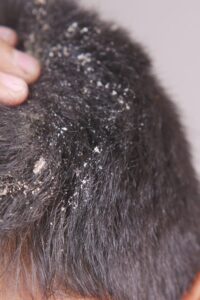
- Rosemary: The Anti-Fungal, Oil-Balancing Herb:
- Rosemary is a potent remedy for the scalp in addition to being used in cooking.
- The fungus that causes oily dandruff, Malassezia, is fought off by rosemary, which is rich in antioxidants and antibacterial substances including rosmarinic acid and carnosic acid.
- Additionally, it enhances circulation to the scalp, which over time promotes the health of follicles and lowers excessive oil production.
- In clinical trials, minoxidil and rosemary oil have demonstrated similar efficacy in boosting scalp health and lowering inflammation.
- Because of its astringent properties, it is perfect for oily scalps because it helps to reduce sebum production and tighten pores without being too drying.
- How to Use: To keep a healthy, flake-free scalp, use leave-in sprays, scalp serums, or rosemary water rinses two to three times per week.
- Tea Tree Oil: Scalp Purifier with Cooling Effect:
- One of the strongest essential oils for antifungal and antibacterial properties is tea tree oil.
- It has a cooling, calming effect that helps lessen irritation and itching while targeting the overgrowth of bacteria that cause dandruff.
- It works well to combat greasy dandruff because its constituent terpinen-4-ol breaks down the fungal cell membrane.
- It can thoroughly wash the scalp without irritating it at low concentrations (2–5%).
- Caution: To prevent sensitivity, tea tree oil should always be diluted in a carrier oil, such as jojoba or aloe gel, before usage.
- When used properly, it restores the oil balance of the scalp and functions as a natural disinfectant.
- Apple Cider Vinegar: Balances pH & Clears Buildup:
- Unbalanced scalp pH is a common cause of dandruff and oily scalp. The pH of a healthy scalp is somewhat acidic (4.5–5.5), which inhibits the growth of fungi.
- Pollution and harsh shampoos can alter this pH, which makes it possible for Malassezia to flourish.
- When diluted with water, apple cider vinegar (ACV) helps the scalp regain its natural acidity, which makes it resistant to fungal growth.
- Its gentle exfoliating qualities also aid in getting rid of dead skin, excess oil, and product buildup.
- Use it as a last rinse after shampooing once or twice a week by combining 1 part ACV with 2 parts water.
- Do not apply to broken or extremely sensitive skin.
- Aloe Vera: Soothes Irritation and Reduces Flakes:
- Aloe vera has a powerful ability to soothe the scalp. Packed with enzymes, amino acids, and vitamins A, C, E, and B12, it hydrates without clogging pores, making it ideal for sensitive but oily scalps.
- It reduces dandruff-induced irritation, eases itching, and facilitates mild exfoliation.
- Additionally, it includes salicylic acid, a natural exfoliator that helps remove flakes and breakdown dead skin cells.
- This is especially helpful if you have scaly dandruff regions.
- Application Advice: Use store-bought gel that is 99% pure or freshly extracted aloe vera gel. For a cooling, detoxifying therapy, apply it immediately to the scalp half an hour before cleaning.
3. A Balanced Scalp Care Routine for Oily Dandruff
- Having the right products is only half the fight if you’re dealing with a greasy scalp and frequent dandruff; you also need to follow a good scalp care regimen that complements your scalp’s natural processes.
- Unknowingly, a lot of people alternate between excessive cleaning and completely neglecting scalp care, which leads to an imbalance that encourages more flakes and greasiness.
- The secret is to establish a well-rounded regimen that addresses inflammation, excess oil, and fungal accumulation without compromising the scalp’s defences.
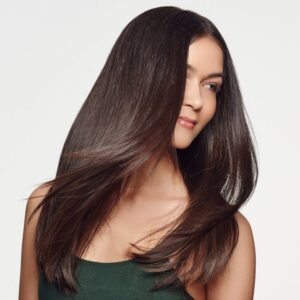
- Step 1: Gentle Cleansing Without Stripping Oils:
- Your scalp care regimen should start with cleansing, but this isn’t about regular washing or harsh shampoos.
- A vicious cycle results from overcleansing, which removes vital lipids and causes your scalp to overproduce oil.
- Instead, pick a pH-balanced shampoo that is sulfate-free and designed to control dandruff and greasy scalps.
- Seek for shampoos that have natural antifungal ingredients like neem, tea tree, or rosemary.
- These effectively cleanse the scalp without depriving it of its natural defences.
- Most persons with oily dandruff find that shampooing two to three times a week works best, though this might vary depending on perspiration, exposure to pollutants, and product use.
- Expert Advice: Make sure to always shampoo the scalp rather than the ends.
- To prevent inflammation and microtears, softly massage with your fingertips rather than your nails.
- Step 2: Weekly Scalp Detox or Clarifying Treatment:
- Buildup occurs from styling products, natural oils, dead skin, and pollutants, even with frequent cleansing.
- This accumulation can obstruct follicles, clog pores, and hinder the effectiveness of active chemicals. Clarity and scalp refreshment can be achieved with a weekly detox treatment.
- Among the options are:
- Oil-absorbing clay-based masks (such as bentonite or kaolin)
- Rinses with apple cider vinegar to restore pH balance and get rid of residue
- Scalp exfoliants with salicylic acid to remove dead cells
- After using one detox technique each week, wash your hair gently and drink some water.
- Step 3: Lightweight, Non-Comedogenic Scalp Moisturizer:
- The idea that oily scalps don’t require moisture is a frequent one. However, an oily scalp can become dry below, which can increase irritation and oil production, much like oily facial skin. Moisturising without clogging is crucial.
- Seek out water-based tonics or scalp gels that contain the following ingredients:
- Aloe vera: Hydrates and soothes without making you feel heavy
- Green tea extract: Reduces sebum and soothes irritation
- Niacinamide: Enhances the scalp barrier and balances oil production
- Steer clear of thick creams or oils. Depending on the product’s directions, apply a tiny bit straight to the scalp either after washing or before bed.
- Step 4: Consistency Over Quick Fixes:
- Perhaps the most overlooked part of scalp care is consistency.
- Dandruff and oily scalp aren’t cured overnight—they’re managed with regular, mindful care. Switching products too frequently, skipping wash days, or overusing treatments can disrupt your progress.
- Stick to your routine for at least 3–4 weeks to evaluate results. Keep a simple hair diary if needed.
- Small improvements in flake reduction, oil control, and reduced itching are signs that your scalp is rebalancing.
- Remember, healing the scalp is a process, not a quick fix.
5. Lifestyle Habits That May Be Contributing to Your Oily Scalp
- When tackling oily scalp and dandruff, most people look solely at products and shampoos.
- But the reality is, your lifestyle plays a major role in the health of your scalp.
- From what you eat to how you manage stress and hygiene, everyday habits could be silently sabotaging your progress.
- Understanding these external and internal factors can help you address dandruff from the inside out, making your scalp care routine far more effective and sustainable.
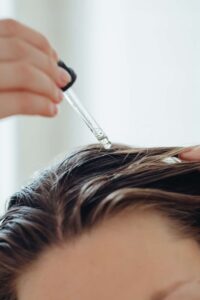
- Stress & Hormonal Imbalance:
- Prolonged stress has an effect on your skin and scalp in addition to your thoughts.
- Your body creates more cortisol when you’re under stress, and this hormone might cause your sebaceous (oil) glands to operate harder.
- This causes the scalp to produce too much oil, which fosters a moist environment that is ideal for the Malassezia fungus.
- Additionally, stress impairs immunity, making it more difficult for the body to regulate microbial proliferation.
- This can result in flare-ups of seborrhoeic dermatitis or dandruff.
- Sebum production can also be increased by hormonal imbalances, particularly those involving androgens like testosterone.
- This explains why a greasy scalp combined with acne or hair loss may be seen by teenagers, those with PCOS, or those undergoing hormonal shifts.
- Diet Rich in Sugar and Processed Foods:
- Like your scalp, you are what you eat. Increased oil production and fungal imbalance on the scalp can result from diets heavy in processed foods, dairy, and refined sugar since they can cause hormonal changes and inflammation.
- Additionally, too much sugar can exacerbate dandruff by feeding fungi and yeast on your skin and in your gut. However, a diet weak in zinc, omega-3 fatty acids, and B vitamins might hinder the function of the skin barrier and the healing process, leaving the scalp more susceptible.
- What works is to switch to a diet high in:
- Whole grains and leafy greens (rich in B vitamins and zinc)
- Omega-3 fatty salmon, flaxseeds, and walnuts
- Yoghurt or fermented meals that contain probiotics (for gut-skin harmony)
- Not Cleaning Hair Tools Regularly:
- Every time you use combs, brushes, hair ties, or even pillowcases, you run the risk of redistributing oil, germs, and product residue to your scalp. You may be unknowingly reintroducing buildup if you’re diligently washing your hair but neglecting to wash your instruments.
- How frequently you should clean:
- Hairbrushes: Every 1-2 weeks to trim hair and give it a shampoo wash
- Pillowcases: Every three to four days, particularly during humid conditions
- Regularly wipe hairbands or headphones with a mild antiseptic.
- A clean scalp results from clean tools. It’s a straightforward but sometimes disregarded step in managing oiliness and irritation of the scalp.
- Wearing Headgear for Long Hours:
- In addition to being occasionally required, helmets, caps, turbans, and scarves can trap heat, perspiration, and oil on the scalp, which can serve as a haven for bacteria and fungi. This is particularly troublesome in hot or humid regions where sweat builds up quickly and air circulation is restricted.
- Tight headgear’s continuous pressure or friction can also irritate the scalp, making dandruff and itching worse in some places (such as the forehead or back of the scalp).
- What is beneficial:
- Put perspiration-wicking lining inside caps or helmets.
- Regularly wash the fabric of the headpiece.
- Between uses, allow your scalp to breathe.
- When feasible, select natural, breathable textiles.
Final Takeaway: Treat the Scalp, Not Just the Hair
- Most individuals concentrate on the hair strands when it comes to hair care—less frizz, more shine, and a smoother texture.
- However, if there’s one significant change that can change your strategy and outcomes, it’s this: a healthy scalp is the foundation of healthy hair.
- It’s likely that you have been treating the symptoms rather than the underlying problem if you’re continuously battling dandruff, oily roots, or itching.
- Dandruff is more than simply a cosmetic problem; it’s an indication that something more serious is amiss, such as the microbiota on your scalp, the way your oil is regulated, or even your way of life.
- If you disregard what’s happening on the scalp itself, utilising masking shampoos or applying serums to the ends of your hair won’t fix the problem.

- Quick fixes like a harsher shampoo, an anti-dandruff spray, or another coat of dry shampoo are all enticing.
- However, treatments frequently address the outward symptoms rather than the underlying cause of the flakes or oiliness. The true change starts when you question yourself:
- What may be causing a fungal imbalance?
- Why is my scalp producing so much oil?
- Is it becoming worse because of my routine?
- Everything changes when dandruff is viewed as a scalp health issue rather than a hair problem.
- You start to realise how crucial it is to maintain pH balance, control your microbiota, exfoliate gently, and stay away from substances that clog your pores.
- This is the change in perspective that results in sustained relief.
- Nature Has the Answers—If You Use It Right:
- Harsh chemicals and artificial formulae are no longer necessary for modern scalp care. Indeed, some of the best components are natural, soothing, and tried-and-true—for example, apple cider vinegar for pH balance, tea tree for cleansing, aloe vera for relaxation, and rosemary for antifungal action.
- These plants do more than merely cover up symptoms. Instead of working against your scalp, they help it repair, restore equilibrium gradually, and lessen your reliance on medications. However, keep in mind that even natural ingredients must be used regularly and with awareness.
- Steer clear of untested or very harsh do-it-yourself tests. Select formulas that are well formulated, thoroughly studied, and appropriate for greasy, dandruff-prone scalps. Gentle doesn’t imply weakness; rather, it indicates long-term effectiveness.
- Consistency is Your Best Treatment:
- Scalp issues don’t happen overnight—and they don’t disappear overnight either. Real progress comes when you commit to a healthy routine, avoid extreme product switches, and give your scalp the care and patience it deserves.
- Be mindful of:
- What you apply (and how often)
- How you cleanse and hydrate
- External habits that affect your scalp—like stress, diet, and hygiene
- Think of your scalp like soil: nourish it regularly, and your hair will thrive naturally. Ignore it, and the same problems will keep returning, no matter what you put on your strands.
FAQS
1. Can an oily scalp really cause dandruff?
Yes, an oily scalp can directly contribute to dandruff. Excess oil (sebum) creates a perfect environment for the Malassezia fungus to grow, which leads to inflammation, itching, and flaky skin.
2. What’s the difference between dry dandruff and oily dandruff?
Dry dandruff appears as small, white, powdery flakes and is often caused by a dry scalp. Oily dandruff is sticky, yellowish, and clings to the scalp due to excess sebum and fungal activity.
3. How often should I wash my hair if I have an oily scalp with dandruff?
Most people with oily dandruff benefit from washing their hair 2–3 times a week using a gentle, anti-fungal or clarifying shampoo. Avoid daily overwashing, as it can worsen oil production.
4. Are anti-dandruff shampoos safe to use regularly?
Anti-dandruff shampoos with active ingredients like zinc pyrithione or ketoconazole are effective but should not be overused. Limit use to 2–3 times a week and rotate with a mild, pH-balanced shampoo.
5. Do natural remedies like aloe vera and apple cider vinegar really work?
Yes, when used correctly. Aloe vera soothes the scalp and reduces flakes, while diluted apple cider vinegar helps balance pH and clear buildup. Consistent use is key for visible results.
6. Should I stop oiling my hair if I have an oily scalp?
Heavy oiling can worsen oily dandruff. If you choose to oil, use lightweight, non-comedogenic oils (like rosemary or jojoba), and avoid leaving oil on the scalp for extended periods.
7. Can stress or hormones affect scalp oiliness and dandruff?
Absolutely. Stress increases cortisol levels, which can stimulate sebum production. Hormonal imbalances, especially involving androgens, can also trigger oily scalp and flaking.
8. Is there a permanent cure for oily dandruff?
There’s no one-time cure, but it can be effectively managed with the right routine, scalp hygiene, diet, and lifestyle changes. Consistency with treatments and avoiding triggers is essential.
9. Can wearing helmets or caps cause dandruff?
Wearing headgear for long hours traps heat and sweat, which can increase fungal growth and oiliness, leading to dandruff. Always clean your headgear regularly and let your scalp breathe.
10. What ingredients should I look for in products for oily dandruff?
Look for tea tree oil, rosemary, aloe vera, salicylic acid, or zinc-based ingredients. Avoid heavy oils, silicones, and sulfates that can clog pores and worsen the scalp condition.
